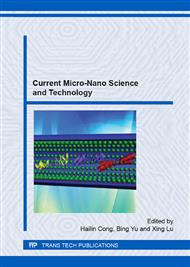[1]
X.X. Feng and SH. Li, Optimization of Multistage Depressed Collector Efficiency, J. Science Technology and Engineering, 10 (10) (2010) 2308-2311.
Google Scholar
[2]
Y. L. Ma, Design Simulation of Multistage Depressed Collector for Coupled Cavity Traveling Wave Tubes, J. Chinese Journal of Vacuum Science and Technology, 29 (6) (2009) 624-636.
Google Scholar
[3]
F. Le Pimpec, R.E. Kirby and F. K King, The effect of gas ion bombardment on scondary electron yield of TiN, TiCN and TiZrV coatings for suppressing collective electron effects in storage rings, J. Nuclear Instruments and Methods in Physics Research, A (564) (2006).
DOI: 10.2172/875817
Google Scholar
[4]
A. Mangiarotti, M.I. Lopes, M.L. Benabderrahmane, etal, A survey of energy loss caculations for heavy ions between 1 and 100 KeV. Nuclear Instruments and Methods in Physics Rearch, A (580) (2007) 114-117.
DOI: 10.1016/j.nima.2007.05.048
Google Scholar
[5]
Liu J, W.N. Lennard, J. -K. Lee, Range of Er ions in amorphous Si, J. Applied Surface Science, 253 (2006) 937-943.
DOI: 10.1016/j.apsusc.2006.01.031
Google Scholar
[6]
A. Shih, J. Yater, C. Hor, etal, Secondary electron emission studies. Applied Surface Science, 111 (1997) 251-258.
DOI: 10.1016/s0169-4332(96)00729-5
Google Scholar
[7]
E.L. Garwin, F.K. King, R.E. Kirby, and O. Aita, J. Appl. Phys. 61 (3) (1987).
Google Scholar
[8]
L. Galan, etal, Surface treatment and coating for the reduction of multipactor and passive intermodulation (PIM) effects in RF components, in: Fourth International Workshop on Multipactor, Corona and PIM in Space Hardware, (2003).
Google Scholar
[9]
Y. F Zhang, Y Wang and W Wei, Technology of coating TiN film on inner face of stasteel pipe by sputtering at low temperature, J. High Power Laser and Part Icle Beams, 19 (8) (2007) 1381-1384.
Google Scholar
[10]
Y. Suesugu, K. Kanazawa, K. Shibata, etal, Continued study on photoelectron and secondary electron yields of TiNand NEG(Ti-Zr-V) coatings at the KEKB positron ring. Proceedings of PAC07, Albuquerque, New Mexico, USA, pp.4054-4056.
DOI: 10.1109/pac.2007.4439958
Google Scholar
[11]
J. Devooght, A. Dubus and J.C. Dehaes, Improved age-diffusion model for low-energy electron transport in solids. I. Theory, Phys. Rev. B, 36 (10) (1987) 5093-5109.
DOI: 10.1103/physrevb.36.5093
Google Scholar
[12]
G. C Yong and M. Y Wei, Strength of copolymer grouting material based on orthogonal experiment. Journal of Central South University of Technology 16 (1) (2009) 143-148.
DOI: 10.1007/s11771-009-0024-4
Google Scholar
[13]
F. Le Pimpec, F. King, R.E. Kirby, M. Pivi and Nucl. Instr. And Meth. A 551 (2–3) (2005) 187.
Google Scholar
[14]
R.O. Jenkins and W.G. Trodden, Electron and Ion Emission. New York, Dover, (1965), pp.54-55.
Google Scholar
[15]
Miyagawa Y, Miyagawa S, Computer simulation of ion beam peneration in amorphous target. J. Appl. Phys, 54 (12) (1983) 7124-7131.
DOI: 10.1063/1.331983
Google Scholar
[16]
Haggmark 1 G, Wilson W D, A new program for ion implantation by Monte Carlo methods, J. Nucl. Mater, 149 (1978) 76-77.
Google Scholar
[17]
X.B. Tian, D.T.K. Kwok, Paul. k. Chu, Modeling of incident particle energy distribution in plasma immersion ion implantation, J. Appl. Phys, 88(9) (2000) 4961-4966.
DOI: 10.1063/1.1319163
Google Scholar
[18]
N. Díaz,S. Castañeda J.M. Ripalda,etal, Materials of Low Secondary Electron Emission to Prevent the Multipactor Effect in High-Power RF Devices in Space, J. 6th Spacecraft Charging Technology Conference, (2009) 205-209.
Google Scholar
[19]
F. F Wu, J. X Deng, P Yan, Effects of Substrate Bias Voltages on the Surface Roughness of TiN Coatings Deposited by Pulsed Filtered Vacuum Cathode Arc Deposition, J. Tool technology, 44(8) (2010) 16-19.
DOI: 10.4028/www.scientific.net/kem.443.481
Google Scholar
[20]
P. He, H.C. Hseuh, M. Mapes, etal: Outgassing and surface properties of tin coated sns ring vacuum chambers. Proceedings of the 2003 Particle Accelerator Conference, pp.788-790.
DOI: 10.1109/pac.2003.1289478
Google Scholar


